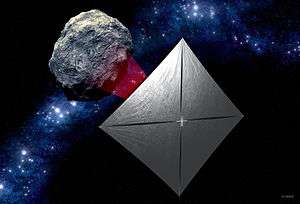Near-Earth Asteroid Scout

The Near-Earth Asteroid Scout (NEA Scout) is a planned mission by NASA to develop a controllable low-cost CubeSat solar sail spacecraft capable of encountering near-Earth asteroids (NEA).[1][2][3] The NEA Scout will be one of 13 CubeSats to be carried with the Orion EM1 mission into a heliocentric orbit in cis-lunar space on the maiden flight of the Space Launch System (SLS) scheduled to launch in 2018.[4][3] A variety of potential targets would be identified based upon launch date, time of flight, and rendezvous velocity.
NASA's Marshall Space Flight Center (MSFC) and Jet Propulsion Laboratory (JPL) are jointly developing this mission with support from NASA's Goddard Space Flight Center, Lyndon B. Johnson Space Center, Langley Research Center, and NASA Headquarters.[1]
Goal
The goal is to develop a capability that would close knowledge gaps at a near-Earth asteroid (NEA), in the 1-100 m range, identified for human exploration.[3][5] NEAs in the 1-100 m range are poorly characterized due to the challenges that come with detecting, observing, and tracking these for extended periods of time. It has been thought that objects in the 1-100 m size range are fragments of bigger objects. However, it has also been suggested that these objects could actually be rubble-piles.[3]
The mission researchers argue that "characterization of NEAs that are larger than 20 m in diameter is also of great relevance to inform mitigation strategies for planetary defense." Also, the NEA Scout target characterization would help inform the Asteroid Redirect Mission.[3]
Proposed payload
Observations will be achieved using a CubeSat performing a close (~10km) flyby, equipped with a high resolution science-grade monochromatic camera to measure the physical properties of a near-Earth object targeted for human exploration, thus, reducing the risks of a crewed mission. Information will be obtained on position/orbit, global physical properties, rotation rate, mass/density, mapping of particles and debris field in target vicinity, albedo and asteroid spectral type, surface morphologies and properties, regolith properties, regional and local morphology.[3]
Design concept
The spacecraft architecture, presented in 2014, is based on a 6-unit CubeSat with a stowed envelope slightly larger than 10×20×30 cm, and a mass of less than 12 kg,[4] a cold gas propulsion system, and primarily based on the use of commercial off-the-shelf parts.[3] Four 7-meter booms would deploy, unfurling the 83 m2 aluminized polyimide solar sail. Mission duration is about 2.5 years.[3]
See also
- Asteroid missions
- Solar sail spacecraft
References
- 1 2 "NASA TechPort -- Near-Earth Asteroid Scout Project". NASA TechPort. National Aeronautics and Space Administration. Retrieved 19 November 2015.
- ↑ Zolfagharifard, Ellie (3 April 2015). "An asteroid hunter, lunar flashlight and DNA kit: Nasa reveals experiments its mega rocket will carry on its first test flight". Daily Mail. London. Retrieved 2015-05-24.
- 1 2 3 4 5 6 7 8 McNutt, Leslie; Castillo-Rogez, Julie (2014). "Near-Earth Asteroid Scout" (PDF). NASA. American Institute of Aeronautics and Astronautics. Retrieved 2015-05-13.
- 1 2 Krebs, Gunter Dirk (13 April 2015). "NEA-Scout". Retrieved 2015-05-13.
- ↑ Castillo-Rogez, Julie; Abell, Paul. "Near Earth Asteroid Scout Mission" (PDF). NASA. Lunar and Planetary Institute. Retrieved 2015-05-13.


